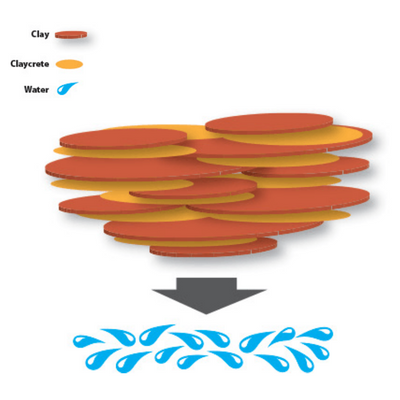
What is Claycrete II™
Claycrete II™ is a chemical soil stabilizer used in all forms of clay soil stabilization, from road bases to surface treatments, grain storage floors and runways
Why Clay?
Claycrete II™ is a unique, patented product to produce strong, flexible and durable pavements. It is a one-time application to treat only the clay content of the building material; if it is necessary to rework the material, add water to bring the mixture to its Optimum Moisture Content, OMC.
The treated clay interlocks into tightly bonded layers; density increases and there is a corresponding decrease in void. Reduction of void means an increase in strength and an improved resistance to water ingress. When the moisture levels reach OMC the compaction process is further assisted by a reduced surface tension. Inter-particle friction is also reduced and compaction effort results in improved density.
The active ingredients in Claycrete II™ are converted during the reaction with the clay. There is no residue, adhesive, binder or polymer left in the pavement. There is nothing to leach out or fail with time and there is no dependency on presence of product for the benefit. This makes Claycrete II™ environmentally safe and permanent.
How Claycrete II™ Works
Construction of durable and structurally strong pavements requires a portion of material that is non-plastic, and does not change behavior or properties when wet. Those particles are larger than clay and the clay acts to fill the smallest voids. Stabilizing the clay with Claycrete II™ will have significant benefits to pavement life and weather resistance.
Once treated with Claycrete II™ the clay particles dry as the free water drains or evaporates. The process of drying is accompanied by shrinking. Without the larger particles the shrinking would result in cracking.
The presence of various interlocking stone pieces leaves the clay as a void filler between the stones, now acting as structural bones. After treatment the clay dries back and, as it shrinks, tension develops. The clay tries to pull on the stone to reduce the growing tension. Since the tension exists in every direction the clay pulls the pavement and tension increases.
A progressive increase in structural strength is a result of this process, and the increasing California Bearing Ratio, CBR, can be measured for several weeks after the pavement is complete. To calculate the amount of clay that is to be reacted, the Clay Fraction of the material is multiplied by the Plastic Index. The resulting value represents the Cation Exchange Capacity, CEC, of the clay. Please see the CEC Calculator for more details.
Claycrete II™ Is Unique
Claycrete II™ is designed to produce results in CEC values between 50 to 400. This might represent a clay fraction of 20% and a Plastic Index of 20. It may also represent a clay fraction of 30% with a Plastic Index of 12 - 15. Using Claycrete II™ can reduce costs associated with materials and maintenance for sealed or unsealed road networks and pavements.
Most of the marginal materials gathered from gravel pits will fit in a CEC value of less than 400. However, when the clay fraction and the PI are high, the CEC may exceed 400. At this point, the results become less predictable and small trials may give the most reliable indication of benefit. Please speak with a Claycrete Global Technical Advisor regarding your project parameters.
Solutions that are practical and cost effective may include the addition of non-plastic material which is suitably graded to build a better balance. This is usually crushed stone between 2mm and 20mm, which will balance the Particle Size Distribution and allow the structural strength of the material to be improved while still retaining the binding and void filling benefits of the clay.
Roads, airstrips, structural floors and base stabilization can all be constructed with in-situ materials without a running surface made from gravel or other resistant material. It is safe to construct in environmentally protected areas, such as game reserves or national parks because Claycrete II™ is certified as a safe chemical soil stabilizer and is environmentally friendly.


